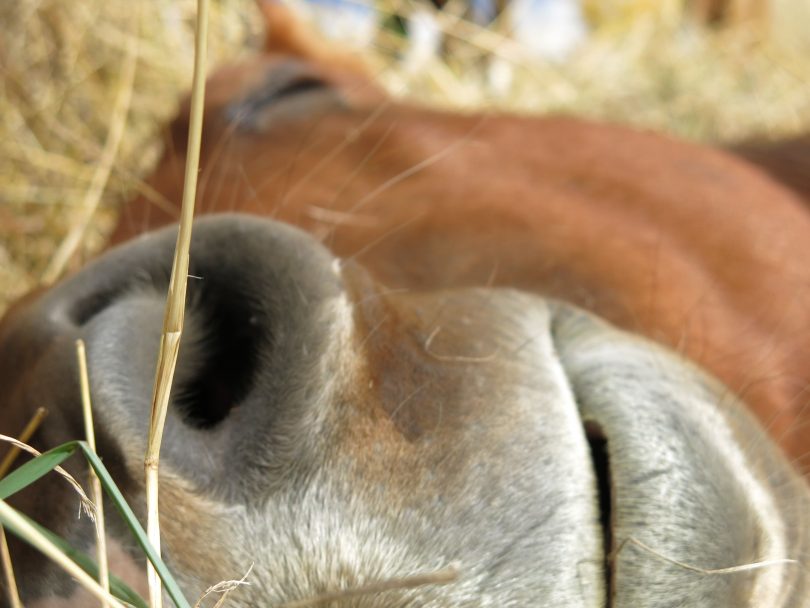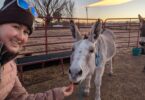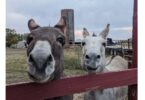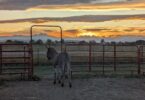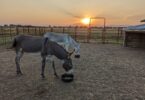How Horses Sleep & Why You Should Care
It wasn’t until my friend’s 17-hand Thoroughbred fell asleep in the cross-ties and buckled to the ground that I really stopped to think about the impact of sleep on horse health. A couple restless days and nights adjusting to a new pasture herd was enough to (literally) topple a giant.
Yet, in my two years of horse ownership, I’d never thought about–much less researched–how sleep might affect my equine partner. So I set off on a mission to understand how horses sleep and why it matters. (And what you can do to help them sleep better with things like Omega-3 supplements.)
Horses rest in one of three positions: standing, lying on one side (lateral recumbency), or lying on their bellies with legs tucked (sternal recumbency). According to Kentucky Equine Research, horses require 5-7 hours of slumber per day. Of that, 30-60 minutes should be recumbent REM (rapid eye movement) sleep to maintain optimal health. Many factors influence the quality and quantity of sleep in horses (e.g. social groups, stimuli, time of day), and poor conditions can lead to sleep deprivation.
Whether you’re a first-time horse owner like me or a pro who simply hasn’t considered this aspect of horse care, we’ve barely scratched the surface on how horses sleep. Let’s dig in.
Sleeping Giants: An Overview of Horses and Sleep
One of my favorite things is arriving at the pasture to find my gelding sprawled on his side, snoring peacefully, fast asleep. There’s something mesmerizing about the sight of these majestic and powerful creatures sleeping in such a vulnerable position.
(Be careful not to startle your horse if he’s catching a few zzzzz’s. Approach slowly, talk softly, and don’t touch him until he realizes you’re there.)
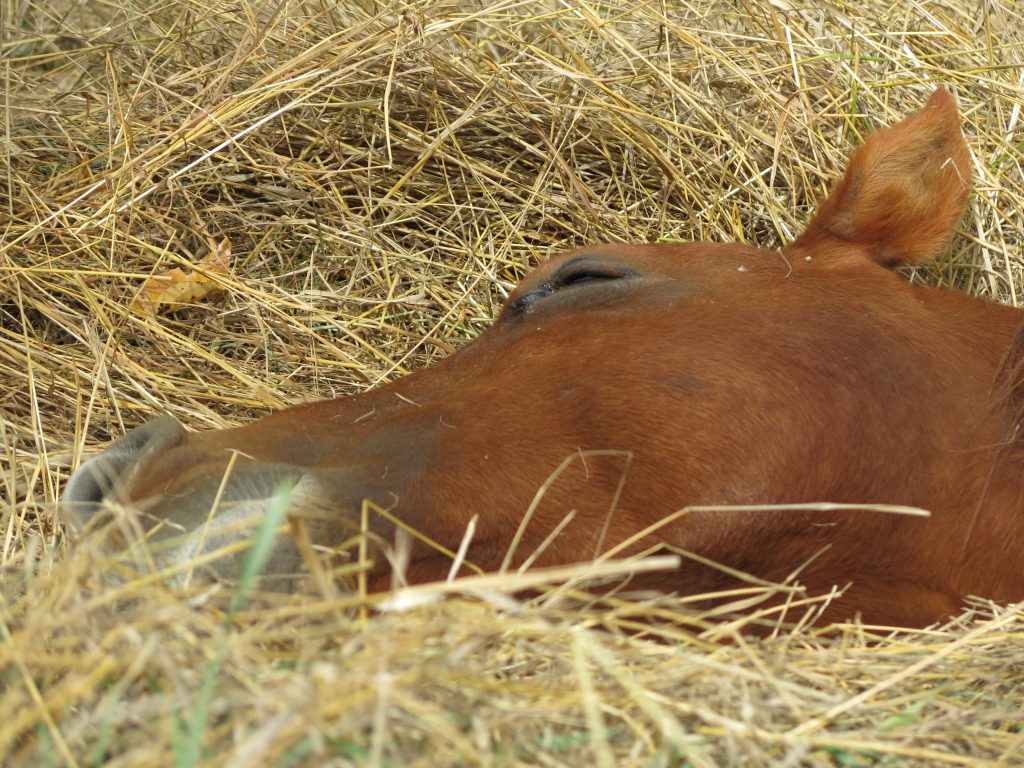
Horses don’t sleep for a single, long block each day like humans do (Source: Horse Rookie)
Sleep is a critical component of horse health and wellbeing, but the act of sleeping is quite different between humans and horses.
For humans, we typically sleep for one extended period of 6-9 hours per day during the night. The less times we wake up during the night, the more rested we typically feel in the morning.
Horses, on the other hand, rest in shorter, scattered blocks of time (15-30 minutes) throughout the day and night. Though this doesn’t sound very appealing to you and me, their behavior makes sense when we consider the nature of prey animals in the wild.
How do wild horses sleep?
Horses are prey animals, meaning they’re always worried about other animals (i.e. predators) attacking them.
“Am I safe?” is the running mantra inside your horse’s brain every moment of every day.
Even though our horses aren’t living in the wild and fending for themselves, their sleep behavior evolved from ancestors roaming the open plains.

Horses are always asking, “Am I safe?” (Source: Pixabay)
Sue McDonnell, PhD, and head of the Equine Behavior Lab at the University of Pennsylvania School of Veterinary Medicine, has been studying wild and tame horse behavior for more than twenty years.
In her 2002 Practical Horseman article “How Horses Sleep,” McDonnell details how herds of wild horses take “power naps” and utilize rotating sentries (i.e. horses who stay standing and alert) to balance their need for rest and safety.
McDonnell also says feral horses sleep more than tame horses and enjoy more down time because the adults divide and conquer watchdog (watchhorse?) duties. “In feral groups, all individuals tend to rest together, eat together, go to water together. The young may get additional rest and sleep during grazing, with the protection of the adults.”
Wild horses also snooze while standing thanks to a special “passive stay apparatus” that helps their bodies conserve energy and doze safely while standing.
Though this type of sleep is “light sleep” versus deep REM sleep. (More on both of those topics later.)
What factors influence a horse’s sleep?
As I learned from my friend’s Thoroughbred, even a seemingly small change (like moving to a different paddock at the same barn) can impact how well our horses sleep.
Common sleep influencers include:
- Where your horse lives (e.g. stall, stall and run, paddock, field)
- Who your horse lives with (e.g. alone, with a couple close buddies, in a bigger herd)
- Where your horse falls in the pecking order (e.g. dominant vs. submissive)
- How old your horse is (e.g. foal, yearling, adult, senior)
- How familiar the surroundings are (e.g. at home, away at a show)
- What’s going on around your horse (e.g. busy show atmosphere, after hours at the barn when everyone’s gone home)
- Whether a horse is tame or wild
- What time of day and season it is (e.g. night vs. day, summer vs. winter)
- What the weather is like (e.g. sunny, windy and rainy)
- What’s changed in your horse’s routine (e.g. moving herds, moving barns, changing training times)
Changes in routine can be especially disruptive to our horses’ sleep cycles. Dr. Joseph Bertone, Professor of Equine Medicine at Cal Poly Pomona, says it can take two to four weeks after such a transition for your horse to return to a comfortable sleeping pattern.
That’s exactly what happened to my friend’s gelding when he moved into my horse’s herd. Her horse was at the bottom of the pecking order, and it turned out that he was getting far less sleep than usual as he adjusted to new social dynamics.
Note: We moved him inside at night so he could catch up on sleep in a stall but still go out with the herd during the day until he settled in.
What happens if horses don’t get enough sleep?
When people are short on sleep, we get tired and cranky. (Just ask any new parent.)
Though horses require less sleep than humans (3-7 hours per day for adults and more for young horses and seniors), not meeting that threshold has real consequences.

Lack of sleep can have serious consequences (Source: Horse Rookie)
If a horse is stressed or sick, and especially if he doesn’t or can’t lie down to get daily deep REM sleep), stay vigilant and call your vet if the behavior persists.
As noted in Sleep and Sleep Disorders in Horses, “Sleep disorders and lack of sleep can seriously compromise horses’ physical activity and even worse, quality of life.”
We’ll talk more about sleep deprivation and other sleep disorders at the end of this article.
Now that you’ve got a basic knowledge of how horses sleep, let’s go deeper on a few key topics and common #horserookie questions.
(Side note: If you’re a horse rookie just getting into riding, check out Horseback Riding: What to Wear to make sure you look the part and have a safe and comfortable experience!)
Check out our summary video about horse sleep:
Getting Comfortable: What are common horse sleeping positions?
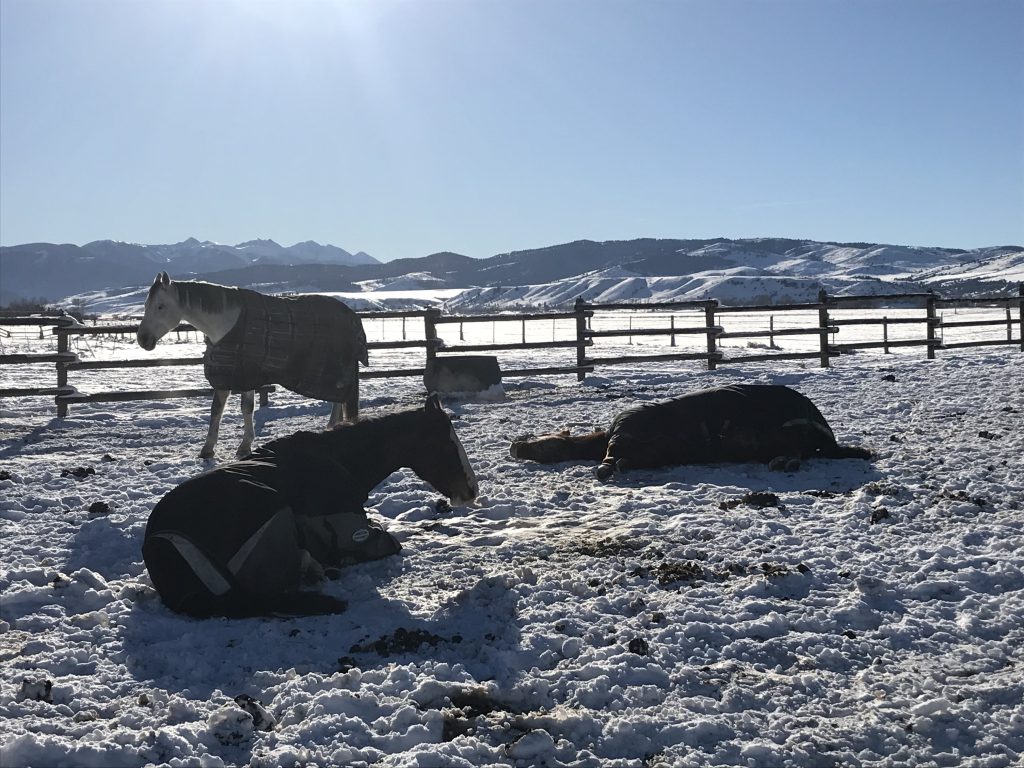
A Sleep Trifecta! Monkey and his buddies showing slow wave sleep (top left), sternal recumbency (bottom left), and REM lateral recumbency (right) (Source: Horse Rookie)
A few summers ago I attended an equine photography retreat here in Montana. (This was before I moved here or owned a horse.)
During one of our free periods to shoot around the ranch, I was surprised to see my favorite horse Charlie flat-out in the field. Initially, I was concerned that he might be sick.
None of the other horses were lying down, and he didn’t move away when I approached.

No caption needed on this special moment (Source: Horse Rookie)
Once I was close enough to touch him (I let him know I was there first), I could see he was fine and just enjoying the sunny afternoon. He let me lay in the grass next to him for half an hour, petting him as he snoozed.
I’d never been close enough to really watch a sleeping horse before, and it’s one of my favorite memories.
Many horse rookies may have the same initial reaction I did if they see a horse lying down. Is it dead? Is it sick? Chances are you’re simply catching him in a period of healthy deep sleep. But, lying down isn’t the only sleeping position for horses.
Down Time: Do horses sleep on their sides?
By now you already know the answer to this question is yes!
But this fact surprises many non-horse people because they may have never seen one lying down. If you’re around horses long enough, though, you’ll see they can sleep lying down in one of two positions.
Position #1: Sternal Recumbency
Sternal recumbency refers to a horse that’s lying down on its belly and chest, withers up, with legs tucked and head and neck off the ground. They may drop their chins onto the ground or sleep with their heads curled around near their elbows.
Personally, I see horses in this position more often in stalls than out in the pasture or paddock. It’s a perfectly healthy sleeping position, though owners should be aware that stressed horses or those fighting disease or injury may also choose this position.
So be sure you know what’s normal (and not normal) for your individual horse. If he suddenly changes his normal sleeping pattern, you may want to do a quick health check.
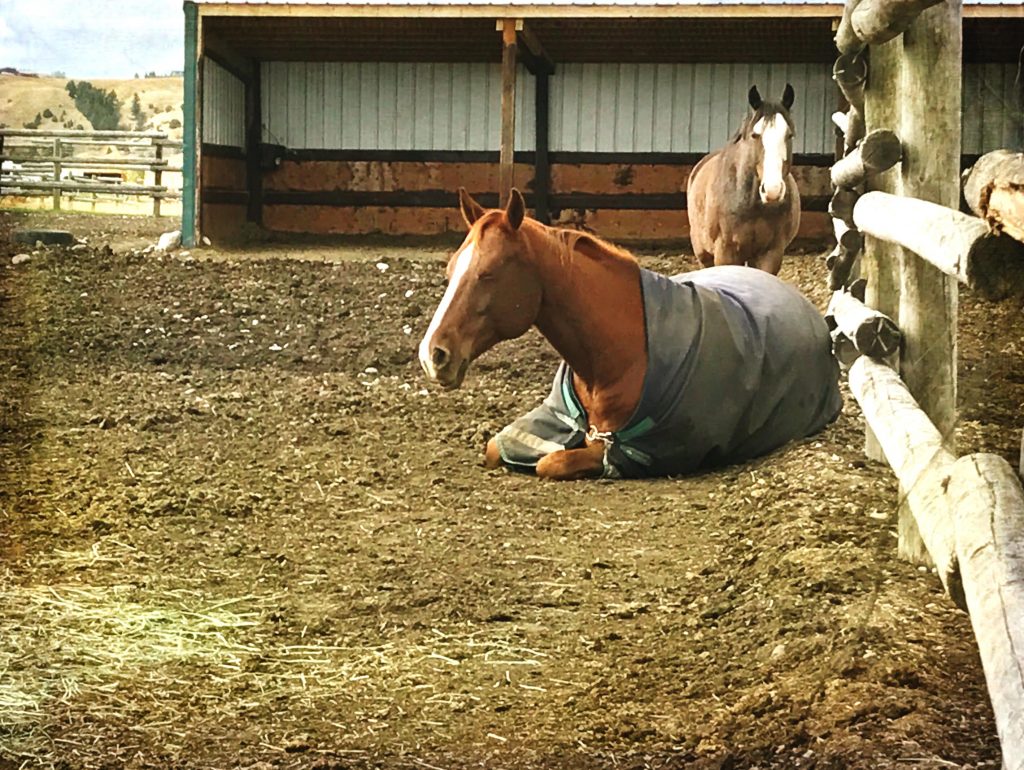
Sternal Recumbency (Source: Horse Rookie)
Note: Want to teach your horse to lie down on cue? Clicker training is the answer!
Position #2: Lateral Recumbency
Lateral recumbency refers to a horse that is lying down flat on one side (right or left). This is how I most often find my gelding sleeping in his shelter or out in the field if it’s sunny.
On bright winter days when the sun is shining in a cloudless sky, I’ve seen more than a dozen horses taking “sun baths” at the same time.
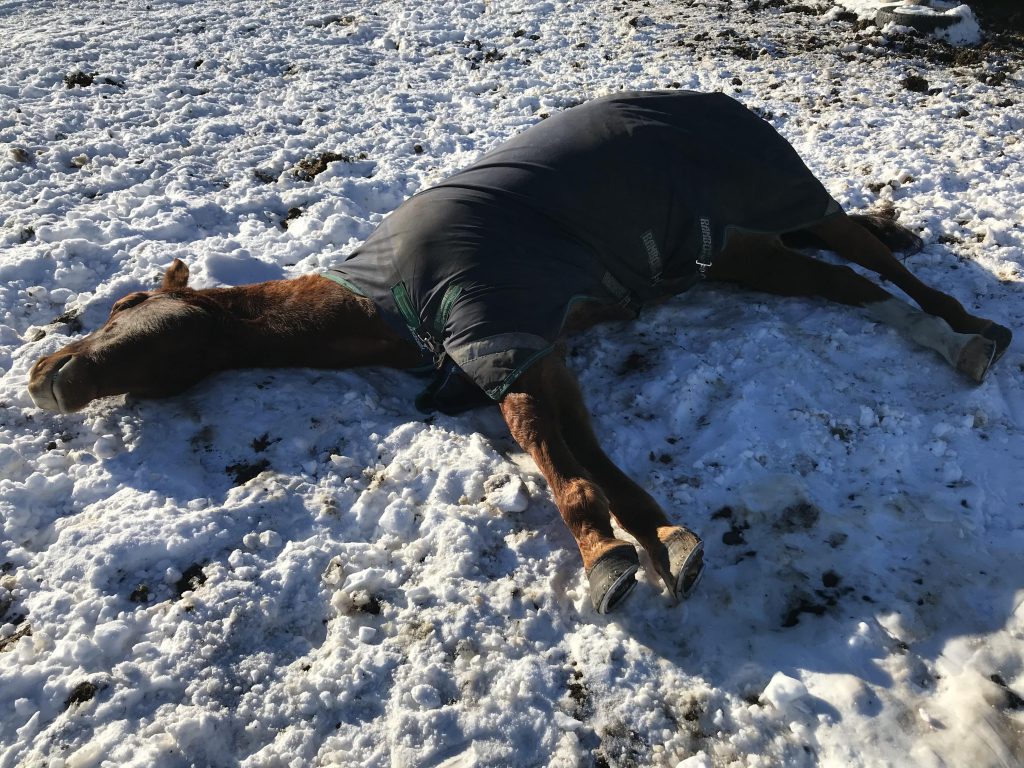
Lateral Recumbency (Source: Horse Rookie)
Sleeping in this position, fully outstretched on one side, is the only time horses can achieve deep REM sleep. (More on that next.) You’ll often see their necks outstretched, eyes barely (if at all) open, and some horses even snore. #cutenessoverload
(According to Horses and Sleep, the “snoring” sound is due to the fact their lungs are under a bit more pressure when lying down.)
Not surprisingly, horses like to be comfortable if they’re going to lay down this way. Can you blame them? I have more pillows on my bed than any person needs!
In Kentucky Equine Review’s Sleep Requirements of Horses article, they recap a research study that compared the sleep habits of horses with different bedding materials (e.g. hard rubber mats vs. shavings or straw). Horses with only mats lay down to sleep less than those with bedding (<30 minutes).
In addition, when the bedding area was larger and shared among horses, hierarchy didn’t impact the ability to lay down. But, when the bedding area was smaller, lower ranking horses were not allowed to sleep as often or for as long.
Bottom line: Sleep is so important that horses compete for it when resources are limited.
Asleep on Their Feet: Do horses sleep standing up?
This is the most common question people ask about horses and sleep, and the answer is yes! (Well, to an extent.)
I like to think about it this way: When you were little and riding the school bus early in the morning, you probably drifted off from time to time–but not for long. Any strange noise or bump in the road would jolt you back to reality.
On the other hand, after a long day at school and playing with friends, you feel deeply sleep once your head hit the pillow for the night.

Do horses sleep standing up? (Source: Pixabay)
Those are two very different kinds of sleep, though your body is technically resting either way. Horses have different kinds of sleep, too.
Standing sleep is known as “slow wave sleep” (SWS), and it looks like exactly what it is–dozing or snoozing.
The horse’s head will lower (mid-way or a bit lower), his eyes will mostly close (or slow blink occasionally), and his lower lip will relax and droop.
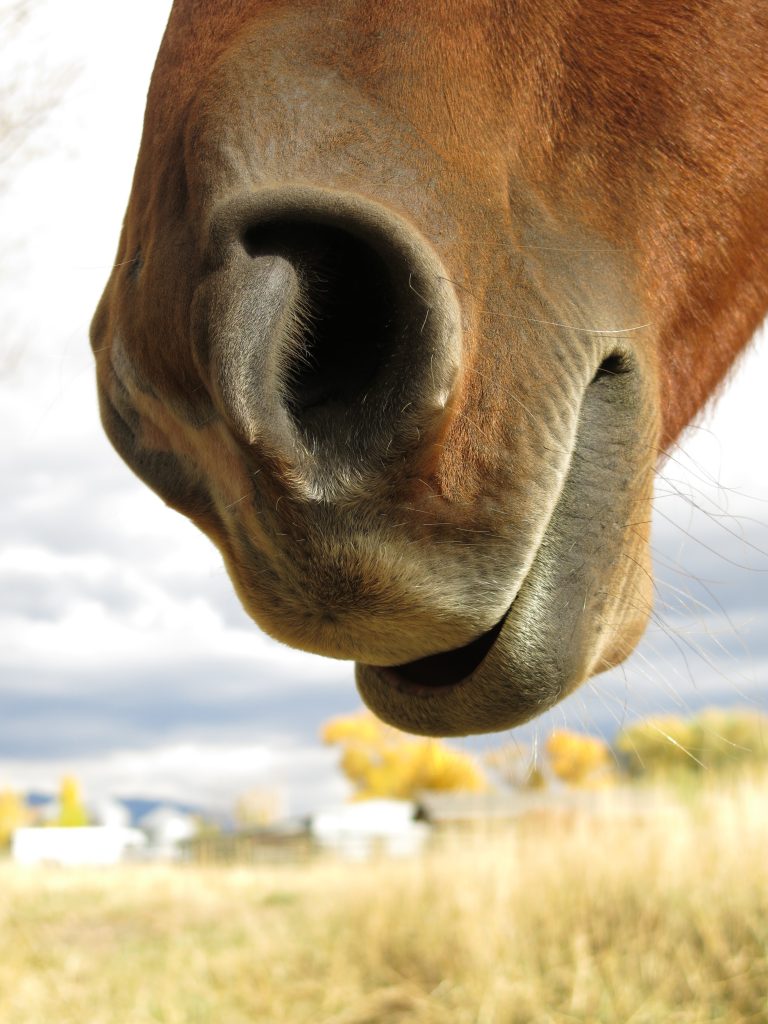
A droopy lip is a tell-tale sign of dozing (Source: Horse Rookie)
Horses do this a LOT. I may catch my horse snoozing a dozen times in a single visit to the barn. According to Sleep Patterns in Horses, this type of drowsing “occurs 8% of the time a horse rests indoors and 13-14% of the time a horse rests outdoors.”
Relaxing activities like grooming or being left alone at the cross-ties while you clean stalls is a perfect chance to see a horse doze standing up. Horses may also doze under saddle when they’re standing in the middle of the arena awaiting their turn to perform. “This is, perhaps, the equine equivalent of sleeping in class,” per Sleep and Sleep Disorders in Horses.
When it’s not our turn to work the cow, for example, I let Monkey relax completely. I can feel him cock one leg, then the other, and simply settle in for a little snooze.
That’s why I’m always careful to give him a heads up (talking to him, adjusting my saddle, etc.) before asking him to move off after a period of relaxation.
Reading List: Pick up a copy of Why Do Horses Sleep Standing Up? 101 of the Most Perplexing Questions Answered About Equine Enigmas, Medical Mysteries, and Befuddling Behaviors on Amazon if you want to learn even more fun facts about horses!
Why do animals sleep standing up?
We touched on this briefly at the start of this piece, but many prey animals (not just horses) are naturally equipped to rest standing up. In fact, “a horse that is laying down isn’t all that comfortable especially when they are mature — and many horses get better rest when on their feet” (Source).
Prey animals need every advantage out in the wild, and being able to sleep standing up is certainly one of them.
It’s like leaving your car in drive while you’re stopped at a stoplight. If you need to hit the gas, you’re already in gear. Similarly, prey animals can quickly run away if danger appears if they’re already on their feet.
You may also notice that horses position themselves strategically while snoozing. Typically they’ll face the “exit,” whether that’s the open side of their shelter or the door or their stall. “They’re like volunteer firemen who back their cars into parking spaces so they can pull out fast,” Sue McDonnell says in How Horses Sleep.
What is the “Stay Apparatus?” (a.k.a Why horses don’t fall down!)
We’ve all been there. You’ve had a long week, you’re stressed, and you’re oh….so…tired. Standing in line at the grocery store (why is there always a line?!), you feel yourself drift off for just a second. Your body tilts, and you jolt awake again.
Humans can’t stay standing and sleep, but horses can. Why? A really cool physical adaptation called the “Stay Apparatus.”
“The stay apparatus is a group of ligaments, tendons and muscles which “lock” major joints in the limbs of the horse. The stay apparatus allows animals to relax their muscles and doze without collapsing.” (Source)

Stay apparatus (Source: Pexels)
Fun fact: This physical trait can be traced all the way back to the now-extinct wild horses called Dinohippus, the first to show an early form of horses’ modern-day stay apparatus. (Source)
It helps to think of the stay apparatus like a hammock that helps the horse “lock” his leg joints while simultaneously relaxing and recharging his muscles. Once a horse engages his stay apparatus, standing requires “virtually no muscular effort.” (Source)
(Though I didn’t know the specifics before researching this piece, I did know that horses lock their legs when they sleep standing up. It’s one of my favorite facts to share with women on the horse and yoga retreats I volunteer at each summer. Who says science isn’t cool?!)
As soon as horses relax their muscles, the stay apparatus automatically engages their front legs. (Read more about specifically how it works here.) For his rear legs, the horse engages the stay apparatus when he shifts his hip and locks his patella (i.e. kneecap) into place. (Source)
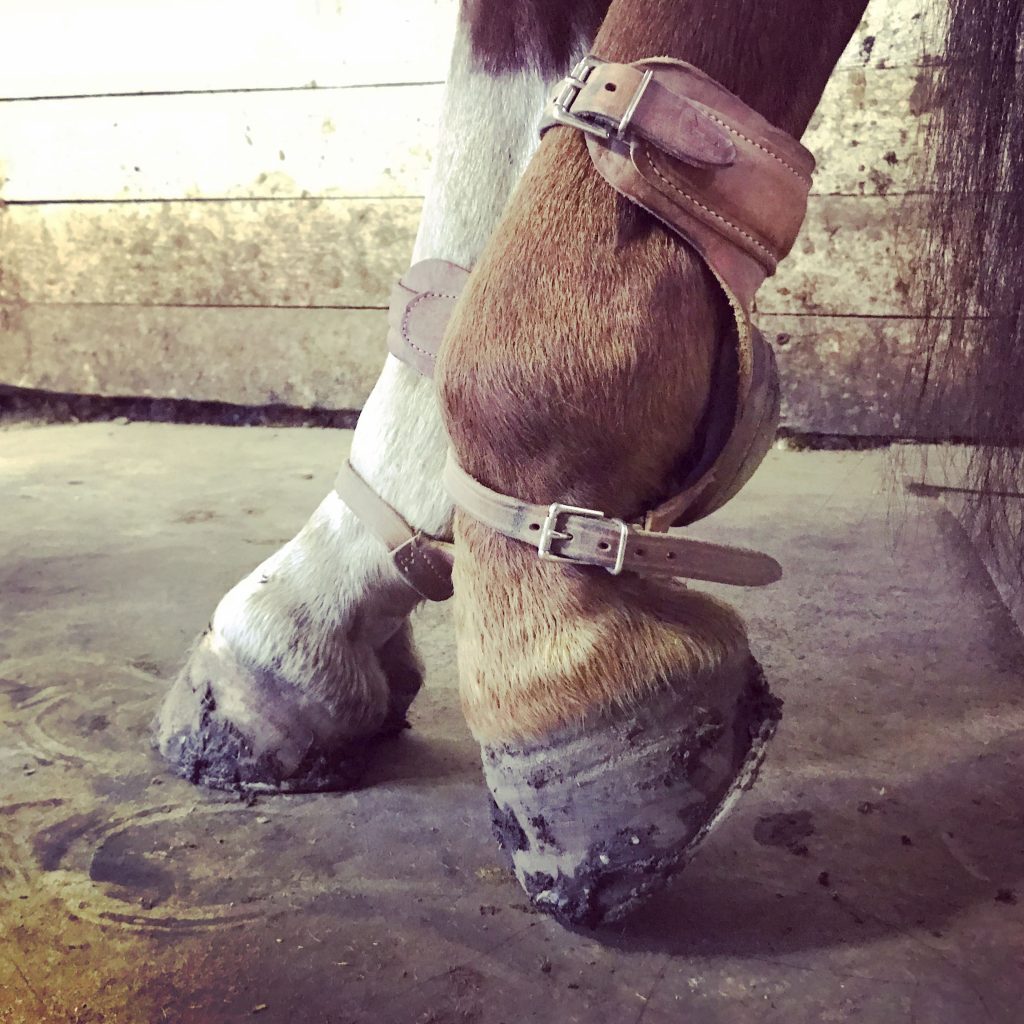
Another instance of the stay apparatus (Source: Horse Rookie)
(If you’ve ever gone on a trail ride and had to wait for everyone else to mount up and adjust their stirrups, you’ve probably felt a horse do this maneuver. Suddenly it feels like one side of your horse dropped six inches… because it did!)
One leg bends or cocks so the tip of the hoof rests on the ground. (See my horse doing this to the right .) The bent leg rests in a sort of “sling” that is non-weight bearing, and he’ll alternate resting each hind leg this way. (Source)
Going Deeper: Horses and REM Sleep

Deep REM sleep only happens when horses are lying down (Source: Horse Rookie)
As we’ve mentioned, horses can rest standing up or lying down in one of two positions. But, only lateral recumbency (i.e. lying flat on one side) allows for the deepest rapid eye movement (REM) sleep. That’s when the horse’s muscles relax enough to reach a state of deep slumber.
Some sternal recumbency REM sleep has been documented, but it’s far more rare than lateral. (Source) Getting enough REM sleep each day is essential to your horse’s health, so it’s worth digging into this topic further.
What is REM sleep for horses?
I’d heard of REM sleep when it comes to people, but I’d never heard about REM sleep for horses. It turns out that it’s very similar to the human variety. During REM sleep, the brain enters a period of “low voltage and mixed frequencies with episodic fast eye movements.” (Source)
Disorganized brain waves aren’t the only indicators that a horse has achieved REM sleep. You may also see your horse twitching his ears or skin, blinking, flaring his nostrils, or even (adorably) paddling his legs as if he’s running in his sleep. (Yep, like your dog does!)

REM sleep is critical to horse health (Source: Horse Rookie)
How much REM sleep do horses need?
Exactly how much REM sleep horses need each day varies (by horse and by research study). But it’s generally accepted that equines spend at least 15% of their total sleep time in REM sleep (Source).
This equates to roughly 30-60 minutes of REM sleep per day, though some studies say this number should be closer to 2-3 hours per day. (Source)
No Rest for the Weary: Horse Sleep Disorders
We don’t take our horses to posh sleep clinics like we might if we’ve been tossing and turning. But animal behavioral scientists do study the sleeping behaviors or horses–and what happens when they can’t seem to sleep properly. That’s right, even horses can have sleep disorders.
Signs your horse may have a sleep disorder:
- Excessive daytime drowsiness
- Abrasions or scarring on knees or legs
- Impaired athletic performance
- Reluctance or inability to lie down
If you suspect your horse may be having trouble sleeping, carefully document the behavior you witness so your vet will have more data to figure out what’s wrong. Take special care to document any changes in your horse’s environment, housing, bedding, social group, wildlife, travel, and known medical issues. (Source)
Side note: If you have access to a video camera (or can rig one in your horse’s enclosure), that’s a great source of data when it comes to diagnosing any potential medical or environmental issues.
What about sleep deprivation in horses?
This summer one of the horses at my barn broke one of his back legs in two places. He had to wear a giant cast and be tied to a high-line in his stall so he wouldn’t re-injure himself while the bones healed.
The vet was actually less worried about the broken bones than she was about the fact he wouldn’t be able to lie down to sleep for at least a month. She warned us his physical condition would deteriorate rapidly as a result.
(After a few weeks, he somehow managed to lie down despite being tied. His urge to sleep lying down was that strong.)
Injury is just one potential cause of sleep deprivation in horses.
My friend’s Thoroughbred mentioned earlier lost enough sleep from changing pastures and integrating into a new herd to collapse in the cross-ties. According to Help Your Horse Sleep Better, even a few days of poor sleep can leave your horse exhausted.
Signs your horse may be sleep deprived:
- Excessive daytime drowsiness
- Sleeping at unusual times (for that particular horse)
- Impaired athletic performance
- Leg/foot soreness (Read our post on horseshoes)
- Collapsing episodes
- Increased travel (e.g. shipping or trailering to shows, races, breeding facilities)
- Hospitalization in a high-traffic/activity area (e.g. intensive care unit)
- Increased anxiety or restlessness
- Changes in noise (e.g. excessive barn noise or activity)
- Fluctuating herd hierarchy (e.g. new horses, dominance being challenged)
- Increased wildlife activity in the area (e.g. mountain lions, coyotes)
Note: Sleep deprivation is sometimes confused with narcolepsy, but sleep deprivation is far more common and much easier to treat. Read on to learn about narcolepsy in horses.
What is horse sleep crashing?
In my research about how horses sleep, I came across the term “sleep crashing” for the first time. But, it turns out I’d seen it in real life–with my friend’s Thoroughbred.
If a horse isn’t getting enough quality rest (especially his daily recumbent REM sleep), he can become physically and mentally exhausted.
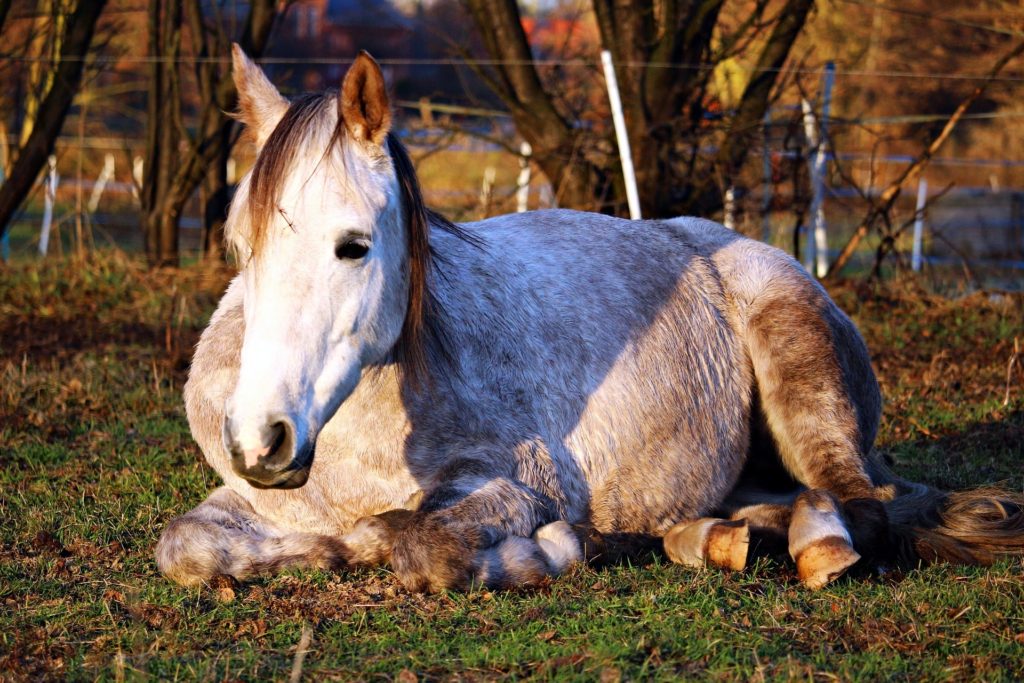
Sleep exhaustion in horses can be dangerous (Source: Pexels)
When that happens, he may drift into deep sleep while standing up. His legs buckle, and he crashes to the ground. It’s scary to witness, startling for your horse, and can result in serious injury. (Source)
Watch for a “nod” where your horse’s head sinks slowly toward the ground. This is the prime indication that leg buckling may follow shortly. According to Trail Horse Rider Magazine, “[If] this happens repeatedly several times a day it seriously affects the horse’s well being and quality of life. Not only is it worrisome and dangerous, but these poor horses walk around all day miserable and exhausted.”
If you think your horse may be sleep crashing, here are some things you can do:
- If you’ve been tying your horse in a stall (like at a show) for extended periods of time, let him free so he can lie down when he wants to sleep.
- Ensure he has a safe and comfortable place to sleep (e.g. clean soft bedding, shelter, roomy stall).
- Move him inside to a stall at night for a few days so he can catch up on sleep without worrying about herd dynamics or weather. (This is what we did with my friend’s horse.)
- If your horses is exhibiting signs of leg or foot soreness, he may be reluctant to lie down. Talk to your vet about using a pain killer like Bute or other joint supplements to make him more comfortable.
- Make sure there aren’t any loud noises during prime sleep hours (night time) that may be keeping him awake.
- Consider whether there are any changing herd dynamics that may be causing anxiety.
- If your horse has been outside alone, you may want to try adding a herdmate. Some horses are only comfortable lying down to sleep if another horse remains “on guard.” (Source)
- Call your vet to rule out other physical issues or sickness.
Safety Tip: Make sure your cross-ties have breakaway snaps. (Whether you have a horse in the barn with sleep crashing tendencies or not, this is simply a wise safety choice.)
Sleep crashing may be easily confused with “girthing” or monotony, but they’re not the same thing.
According to Behind the Bit, “Some horses fall when girthing, and it’s believed that in some horses the girthing process “hits a nerve.” The solution is to tighten the girth very slowly.”
Rarely, a horse may lie or fall down from sheer boredom (e.g. waiting around at a show, being braided for a long time). We had a horse in one of our riding clinics lie down twice during the lesson. He was physically fine, but mentally “over it.” He decided that was enough riding for one day!
What is narcolepsy in a horse?
We have a family friend suffering from Narcolepsy, and it’s a tough sleep disorder to manage. Narcolepsy is characterized by “excessive daytime sleepiness and abnormal REM sleep manifestations,” (Source).
Horses (and dogs) can also be diagnosed with Narcolepsy, and it’s most often noticed during “periods of inactivity or from certain triggers like cold hosing,” (Source). In Sleep and Sleep Disorders in Horses, there were several interesting cases mentioned:
“[A two-month old Lippizan] filly had “sleep attacks” when turned out in a pasture with her dam. The filly made attempts to play and follow mom at a gallop, but she struggled to stay awake while playing…In one report, a horse was said to “fall in a heap” after being startled. In another case, a 6-wk-old pony crossbreed had frequent episodes of falling asleep and collapse triggered by excitement (play time and going to pasture with mom), eating (nursing and chewing hay), and drinking that almost caused the colt to drown.”
If you’re not sure whether the symptoms you’re seeing are sleep deprivation or a more serious condition like Narcolepsy, consult your veterinarian.
What about excessive sleeping in horses?
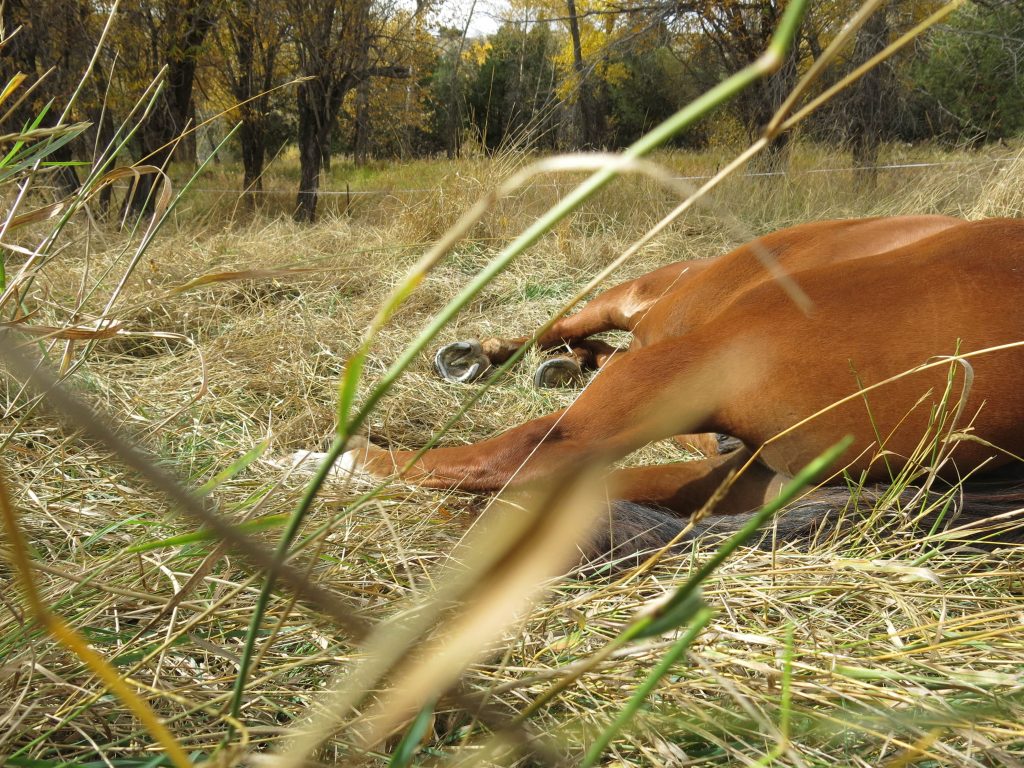
Can horses sleep too much? (Source: Horse Rookie)
Excessive sleeping, or Hypersomnia, can also be an issue with horses. It’s less common than sleep deprivation, so make sure that isn’t the cause first. In Sleep and Sleep Disorders in Horses, the author notes “These horses may lack periods of REM sleep despite being seen lying down, which can result in excessive episodes of sleep. A common complaint in these horses, besides excessive sleep, is decreased or poor performance.”
Again, don’t feel badly if you can’t self-diagnose your horse’s symptoms. It’s always best to consult your vet to properly assess which sleep disorder (if any) your horse may be suffering from.
Frequently Asked Questions About How Horses Sleep
Do horses sleep with their eyes open?
Can horses get catch good “shut eye” if their eyes are still open? Yes, horses may not close their eyes all the way if they’re in slow wave sleep (standing sleep). They might even occasionally blink as they move in and out of alertness while dozing.
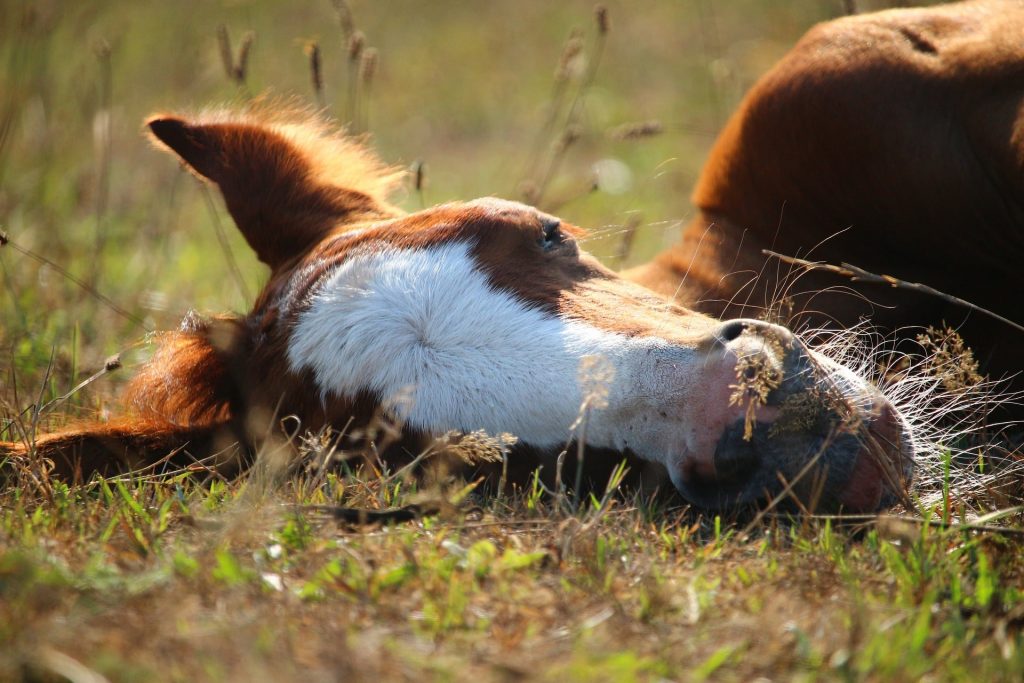
Can horses sleep with their eyes open? (Source: Pixabay)
Even horses in REM sleep (lying down) may twitch, which can make it appear as if their eyes open. These little flickers are just a sign of your horses reaching a deep state of sleep.
Why don’t horses lay down?
Horses do lie down, but sometimes it’s hard to catch them “in the act.”
Horses will only lie down to get their deep REM sleep when they’re truly comfortable in their environment, secure in their herd dynamics (if not stabled alone), and feel other horses will stay “on guard” while they catch some zzz’s.
How do horses lay down?
We wouldn’t call it graceful… but horses have learned how to lie down and get back up easily. (Young foals have a bit more trouble because their legs are so darn long!) Here’s a great example how horses lie down.
https://www.youtube.com/watch?v=6bnjWEaQ1Ks?rel=0
Do horses dream?
The short answer is we’re not sure, but it’s likely!
People and dogs dream during REM sleep, and horses seem to exhibit dream-like behaviors too.
Aside from sometimes “talking in their sleep” (i.e. grunting or snoring), horses in REM sleep may move their eyes rapidly back and forth under their eyelids. Animal Behaviorist McDonnell “has even seen some horses move their feet as if “trotting” in their dreams. But what horses dream about is anyone’s guess.”
Do horses sleep at night?
Yes, horses sleep at night. But horses don’t only sleep at night! Unlike humans, horses get their sleep in shorter bursts throughout the day and night.
According to PetMD, “A typical night as a horse will involve grazing, snoozing standing up, and short periods of lying flat out to get some serious shut eye.”
If your horse is stalled instead of kept outside in a pasture or paddock, he’ll likely get most of his rest during the night and early mornings when the barn quiets down and people activity is low. Per McDonnell, “Horses tend to learn the pattern of the barn,” Sue McDonnell says, “and their deepest rest and sleep tend to occur soon after the busy ‘people day’ ends.”
How long do horses sleep?
According to Kentucky Equine Research, 5-7 hours of sleep per day is normal for horses. When it comes to deep REM sleep, they need 30-60 minutes to maintain optimal health.
But horses don’t sleep in a single block of time like humans do. They catch “power naps” throughout the day and night of as little as 5-15 minutes at a time. Why? According to Kentucky Performance Products, “[wild] horses needed to be able to function with sleep interruptions from predators or looking out for predators.”
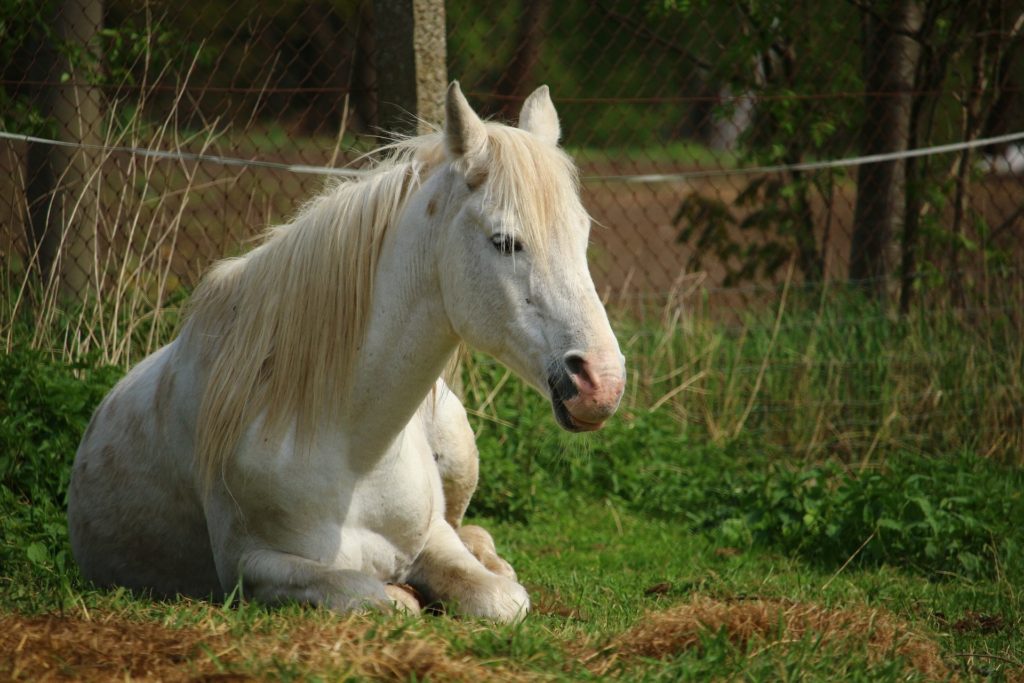
How long do horses sleep? (Source: Pixabay)
How many hours do horses sleep in a 24 hour period?
According to Kentucky Equine Research, horses need around 5-7 hours of sleep each day and 30-60 minutes of deep REM sleep. Horses sleep in short spurts so they can stay ready to react to any external dangers in their environment.
Note: Different research studies vary slightly in the optimal amount of sleep horses need. Check with your vet if you want a second opinion.
How do baby horses sleep?
Baby horses (like baby humans) spend more of their time sleeping. Oh, to be young again!
Generally, the younger the horses the more sleep he needs. According to Sleep Patterns in the Horse, “[foals] sleep is 50% of daylight time at birth (⅓ recumbent) then drop to adult levels by 7 months old…It is believed that the large amount of time the foal spends in recumbency is necessary for the assimilation of information obtained during waking periods into a long-term memory trace.”
You’ll most often see foals sleeping flat out on their sides (and it’s totally adorbs). Like adult horses, young horses also love sleeping on deep soft bedding and sun bathing. Who wouldn’t?

How do baby horses sleep? (Source: Pixabay)
Does weather affect horse sleep?
Weather does affect how much and how well horses sleep. A big weather front rolling in can make horses hesitant to let down their guards and sleep, and windy conditions tend to make horses quite hyper.
Ground conditions also influence whether horses want to sleep (especially lying down). I wouldn’t want to sleep in a mud puddle or on gravel, and horses don’t either. Sunny temperate days are prime sleep times, but you’ll also find horses happily snoozing on winter days as long as the sun is out.
My horse lovvvves to sleep flat-out in his paddock on sunny winter days. The snow on the ground doesn’t bother him one bit!
How do miniature horses sleep?
Miniature horses sleep like any other type of horses (except cuter?), which means standing and lying down in short spurts throughout the day and night. They need both slow wave sleep (standing) and deeper REM sleep (lying down) to stay healthy.
Does cribbing affect sleep?
Cribbing is a behavior where a horse grabs things like stall doors or fence rails with his teeth and sucks in air with a grunt.
Cribbing can affect the quality and quantity of a horse’s sleep. One British study found that “…cribbers often don’t sleep on their feet or have as much slow wave sleep as other horses, 48 percent less.” (Source)
If your horse cribs, be especially vigilant about sleep deprivation. Talk to your vet if you see signs of trouble.
How long can a horse lay down safely?
Horses typically sleep in short bursts throughout the night and day, anywhere between five minutes and upwards of an hour (if undisturbed). If you notice your horse is spending excessive amounts of time sleeping during the day, talk to your vet about the possibility of a Hypersomnia sleep disorder.
What other animals sleep standing up?
According to National Geographic, “most four-legged land herbivores—cows, moose, rhinos, bison, and horses among them—can doze lightly on their feet, but they have to lie down to sleep deeply.”
Are there sleep aids for horses?
There are several ways you can encourage better sleep in your horse. Kentucky Equine Research Nutritionist Kathleen Crandell, PhD, recommends several joint supplements that can make it easier for your horse to lie down and get back up.
Specifically, she says “Joint supplements that contain glucosamine and chondroitin sulfate, hyaluronic acid, and omega-3 fatty acids all support healthy joints. These types of products lubricate the joints and help decrease discomfort and inflammation… potentially making it easier for horses to become recumbent and more easily stand after REM sleep.”
Kentucky Performance Products also has advice for managing inflammation, calming anxious horses, and adjusting diet for optimal sleep.
- Staying Loose: Consider adding Omega-3 fatty acids to reduce inflammation (with your vet’s input, of course). “Hyaluronic acid, chondroitin sulfate, glucosamine, and manganese sulfate fed at the proper levels have all been shown to reduce the effects of normal wear and tear, limiting damaging inflammation.”
- Staying Calm: If anxiety is causing your horse to lose sleep, consider supplementing thiamine (B1), magnesium, taurine, and alpha-lactalbumin to encourage healthy nerve and muscle functions. (Ask your vet first.)
- Staying Balanced: Glucose metabolism can also result in anxiety and stress hormone spikes. “Choosing feeds high in fat and fiber that are slowly metabolized help to limit hormone spikes.”
Test Yourself: Horse Sleep Quiz (Level 1)
Hitting Snooze: Summary of How Horses Sleep
Whew! If you’ve read this entire article, you’re a horse sleep rookie no more. Not only do you understand how horses sleep physically (both standing and lying down), you know what type of sleep each position produces.
You also understand why horses need each type of sleep and what happens if they don’t get enough rest. From sleep deprivation to hypersomnia, narcolepsy to sleep crashing, you’re on the lookout for common symptoms of trouble.
Most importantly, you’re now convinced that sleep is a BIG deal for your horse’s overall health and happiness. Plus, you got a lot of practical tips to help your equine beauty get his beauty sleep.
Happy trails!
P.S. Enjoy this article? Trot on over to:
- Teach Your Horse to Lie Down on Cue (Step by Step)
- Equine Athlete FAQs: How Long Can a Horse Run?
- How Long Can Horses Lay Down?
- Equine Shelter 101: Do all horses need a stable?
- Horse Hay FAQs (List of Types of Hay, The Best Hay for Horses, etc.
- Why (Good) Horseshoes Don’t Hurt Horses
- Horse Trailer Weights by the Numbers
- Food or Foe: What HorsesEat (And Why)
- Fact or Fiction: Do Horses Eat Meat
- Home Sweet Stable: How Big Should a Horse Stall Be?
Resources
How Horses Sleep by Sue McDonnell in Practical Horseman
Horses and Sleep in Horse Junkies United
Sleep and Sleep Disorders in Horses in AAEP Proceedings
Sleep Patterns in Horses in Equine Practice
Stay Apparatus on Wikipedia
Horse Behavior on Wikipedia
Contrary to Popular Belief, Horses Do Not Sleep Standing by PetMD
Help Your Horse Sleep Better in Equus
How Horses Sleep Part 2 in Practical Horseman
Equine Sleep Crashing in Trail Horse Rider Magazine
Is Your Horse Sleep Crashing in Behind the Bit
Horse Sleep Patterns and Requirements in Kentucky Performance Products
Sleep Requirements of Horses by Kentucky Equine Research
Do Big Animals Always Sleep Standing Up in National Geographic
994
994

